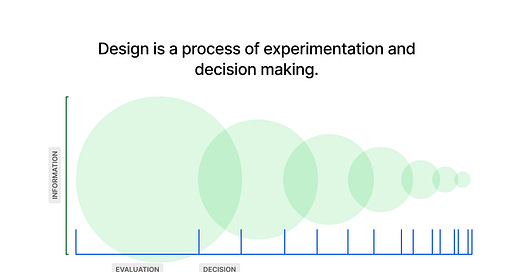Moving past your own design decisions
Last week one of the engineers I work with complimented me on my ability to move on from my past design decisions. She called it “impressive”. I said “thanks”, blushed and started thinking about how I developed that skill.
It made me think of Tanner Christensen’s diagram of the design process as a series of progressively narrowing circles for two reasons:
It highlights the iterative nature of refining your understanding and focus over the course of designing a product.
It hints at a feeling I get each time I’ve reached a smaller circle when I look back up a level and think to myself “oh, well, I guess I wasn’t quite as right as I thought”.
My work as a designer is often defined by that constant evolution; the gradual narrowing of my focus on the true problem I’m trying to solve.
Each and every project I go through the same cyclical process of experimenting, testing and making decisions until I’ve eliminated the designs that clearly don’t solve the problem.
But even when I feel like I’m nearing the end, there’s never a time when I know with 100% certainty that the design is the right one. Because there is no one perfect design; there are always many potential executions. So instead of striving to get it “right” I just strive to keep narrowing the circles and keep making more informed decisions.
The beauty of designing software is that it’s made for that type of evolution. But the flip side is that it means you’ll frequently be confronted by your own previous design decisions. I’ve found that the key to making sustained progress is just to treat your past self with some grace. You took action and made the best decision you could given the information available at the time. But now you have new, better information and an opportunity to take an improved action. So take it.
Don’t let your ego stand in the way. Keep moving on. You’re going in the right direction.
If you found some value in this post, consider subscribing, sharing or following me on Twitter.





